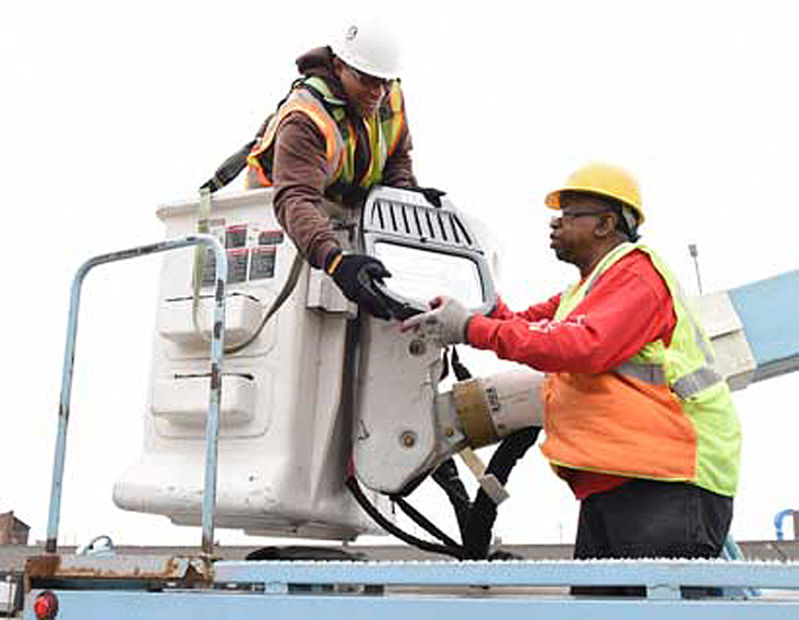Chicago completes smart streetlight project
- February 14, 2022
- Steve Rogerson

Chicago has completed its CSLP smart lighting programme, a massive streetlight modernisation project that has improved the quality of night-time visibility throughout the city and is projected to save taxpayers $100m in electricity costs over the next ten years.
City officials cut the ribbon for the project this month, primarily executed by the Chicago Department of Transportation (CDoT), at the Lyon’s View manufacturing plant in K-Town on the West Side, where more than half the lights were assembled by Chicago residents.
“Our smart lighting programme will shine a clearer and crisper light on our streets and sidewalks to allow pedestrians, bicyclists and drivers to see other people and objects,” said Chicago mayor Lori Lightfoot. “Aside from significantly enhancing public safety, this programme has also created jobs for some of our most vulnerable residents, is helping us achieve our climate goal of reducing our carbon footprint, and will deliver major, long-term savings for the city.”
The modernisation project involved converting more than 280,000 outdated, hazy orange high-pressure sodium (HPS) streetlights, about 85 per cent of the city’s streetlight stock, to high-efficiency LED lights. These LED fixtures use less than half the energy of the HPS lights and can last for twice as long.
The project also created one of the largest and most reliable smart technology infrastructure systems in the country and established a national model for other cities as they update their streetlights. The LMS smart lighting management system was created in collaboration with the city’s Department of Assets, Information & Services (AIS) and relies on wireless nodes attached to each fixture. The nodes are part of a network that detects a streetlight outage, automatically creates a repair ticket and assigns repair crews to respond to the location.
“Creation of the lighting management system puts us in the forefront of smart cities around the nation,” said CDoT commissioner Gia Biagi. “The programme has made Chicago a greener city and is providing clearer, more reliable night-time lighting in every neighbourhood. And the smart lighting management is making our operations more efficient, enabling our workforce to respond to outages more quickly when they occur.”
The24th Ward alderman Michael Scott Junior added: “Residents of the West Side and the 24th Ward are pleased to see that the CSLP is delivering improved night-time visibility and safety. I am proud to stand with the mayor as we cut the ribbon on a project that generated jobs and economic opportunity for residents in my ward.”
The prime contractor for the $160m programme was Ameresco.
“We commend the city of Chicago and its leadership for completing a project that has become a blueprint for future smart lighting implementations,” said Lou Maltezos, executive vice president of Ameresco. “One of the major benefits of the Chicago smart lighting programme is, of course, the energy savings which then translates into cost savings, and ultimately a reduction in the city’s carbon footprint. The carbon reduction impact of this project is significant and estimated to offset more than 134,600 metric tons of carbon dioxide or the equivalent of powering 16,000 homes’ energy use for one year.”
In designing the programme, the city prioritised hiring a diverse set of subcontractors and emphasised the importance of job creation for residents. The programme set a minority business enterprise (MBE) participation goal of 26 per cent and a women’s business enterprise (WBE) participation goal of six per cent, both of which were exceeded. In addition, it included a requirement that half of the workforce consist of Chicago residents and a tenth of workers come from socio-economically disadvantaged areas. These goals were also exceeded.
A key vendor for the programme was Lyons View, a certified MBE based on the West Side that is dedicated to creating job opportunities for residents with barriers to employment. The company features non-discriminatory hiring practices that allow a second chance opportunity to job applicants. Lyons View assembled more than half the LED fixtures used in the programme.
“The Chicago smart lighting programme has been a springboard for our company,” said Josh Davis, CEO of Lyons View. “We have garnered support and investment from world-class organisations and grown into a 60,000 square foot facility in Chicago’s K-Town business centre. We look forward to continuing to grow our business on the West Side and taking advantage of the growing opportunities in the energy efficiency sector of the economy.”
When the programme was launched in 2017, the city prioritised equity by installing the first new LED streetlights in South and West Side neighbourhoods with heightened public safety concerns, allowing those communities to reap the benefits of higher quality, more reliable lighting quickly.
The programme is already providing environmental and financial benefits, cutting energy usage and electric costs by more than half. In 2021, the city reduced its energy bill for streetlights by more than half, registering savings of $8.7m. With energy prices on the rise, the city projects $100m in savings over the first ten years. In addition, the city has received almost $34m in rebates from the utility ComEd for swapping inefficient HPS fixtures for energy-efficient LED streetlights.
“ComEd is proud to support the city of Chicago and local, minority-owned businesses, like Lyons View, in their efforts to reduce energy and maintenance costs across our communities,” said Gil Quiniones, CEO of ComEd. “The installation of smart street lighting provides both environmental and safety benefits for the surrounding community while lowering the city’s costs on energy use and maintenance so that those funds can be used elsewhere. We look forward to our continued work with the city of Chicago to deliver ongoing grid enhancements that will improve reliability and quality of life for the customers we are privileged to serve.”
The design of the lights also reduces light pollution into the city’s night sky. This is because LED lights are shielded to direct light downwards onto the street and sidewalks, instead of up into the night sky as HPS fixtures do.




